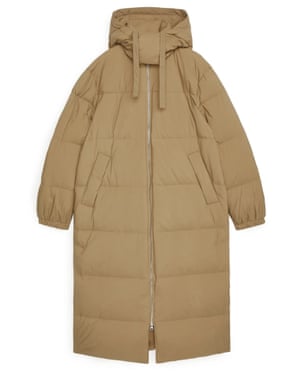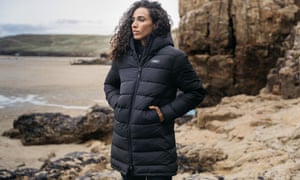Few garments will make you feel as if you are being spooned by a considerate lover. Enter the duvet coat, a long, puffer-style cocoon that is more than a jacket. Soft and padded, cosy and water-resistant, it is a place to hide in plain sight, a sanctuary against the world and the weather.
With so many of us unable to socialise indoors, these coats have become a topic of fevered discussion on social media. (“Everyone get yourself a duvet coat. I am so warm and cosy life almost feels worth living,” one fan tweeted.) Could this be the answer to the coming Covid winter?
Well, yes, but not all duvet coats are equal. Some are eye-wateringly expensive. Some look the part, but don’t protect from the elements. Many are filled with down, and so out of bounds for vegans. And, of course, they are not universally flattering. There is a real chance of looking like an Arsene Wenger meme or an over-inflated tyre. So here is everything you need to know to be stylishly swaddled this winter – and in many more to come.
Why are duvet coats so warm?
They are made up of “baffles”, pockets created between two layers of fabric that are filled with down, or a synthetic equivalent. The pockets trap body heat, and create a cocoon of cosiness akin to the 1980s Ready Brek advert.
Are big baffles warmer?
Not necessarily, says Anita Marcella Palacios, of the outerwear brand Maium. “It depends on the amount of filling per baffle.” When shopping, then, squeeze the baffle to gauge how toasty it is likely to be. Also look out for standardised measurements (such as “600 fill power” for down versions) or a simple statement, such as “our warmest jacket”.
Which other design details will keep me cosy?
Debbie Luffman, product director at the sustainable outdoors brand Finisterre, advises avoiding dry clean- or handwash-only coats because dirt can “clog the fabric pores” and render them less breathable. She also recommends finding a coat that can be tumble dried, as this fluffs up and disperses the filling within the baffle. Always go for a zip, not poppers, says Luffman, and a hood; and aim for an extended collar.
Knitted cuffs keep more air out, as does a placket – the fabric flap that hides the zip – and “seamless” stitching. With longer styles, says Luffman, a double zip is essential, so that if you want movement or extra air, you can unzip the lower part of the coat without exposing your chest and throat to the cold.
How should it fit?
Fit is key. If you want to wear a jumper underneath, and you probably do, you need a coat big enough to fit snugly over it, comfortably. But don’t go too big because you will lose body heat.
Are duvet coats waterproof?
Read the small print. Most duvet coats would be labelled water-repellent at best (look out for the term DWR, meaning durable water repellent; less high-spec are water-resistant, then showerproof). Some don’t mention waterproofing at all; in that case, assume you’ll get sodden.
We did find a couple of fully waterproof options at the premium end of the market, such as Maium, but there will likely be a trade-off in in breathability. In most cases, you will need a waterproof outer layer for downpours. Or you could switch to a less cushiony waterproof parka or slim puffer body warmer under a waterproof. There are many situations in which you might want a shorter jacket, from hiking to cycling. “You have to decide what is more important,” says Luffman. In duvet coats, as in life, you can’t have everything.
How much will all this cosiness set me back?

The very high-end duvet coat market is, frankly, a bit silly. Canada Goose, which sells status duvet coats for about £895, has “cold rooms” in stores where shoppers can try on coats at -25C. Unless you’re going to the Arctic, that is not necessary. Luffman says that reputable outdoor brands – such as Rab and Patagonia – rate as the best place to find a reliably weatherproof coat; most will charge at least £200, which Luffman believes is about the price you should expect to pay for a well-crafted technical coat. However, if this is too steep, there are lots of secondhand bargains on eBay, which can also be a more environmentally friendly way to buy.
Nicolas Bargi, of the animal-free brand Save the Duck, urges caution with fast-fashion makes, because the business models focus on restocking sell-out products at high speed, which is generally incompatible with the months-long process of creating outdoor clothing. The brand many consider the best on the high street if you are happy to wear down, is Uniqlo, the master of affordable duvet coats; see its seamless duvet coat, for £159.90, with “durable water repellency”. Also, if you know what you are looking for and can spot a high-street coat that offers many of the design details mentioned above – as with this coat from Arket or this from Marks & Spencer – you may be on to a winner.
Can you wear down without hurting ducks and geese?
I’m afraid not. Down is officially a meat industry byproduct and there have been many reports of cruelty in down harvesting. Recently, brands including Arket and Patagonia have used recycled down instead. Many brands have signed up to the Responsible Down Standard, which audits suppliers annually and aims to avoid “unnecessary harm”, but Peta’s view is that all of this is marketing and it is “impossible for down ever to be responsible”.
Are synthetic equivalents any good?
Bargi insists they are and says his filling, Plumtech, for example, is just as warm, not to mention waterproof, breathable and quick to dry. The only drawback, he says, is weight. This was a challenge when Bargi created an insulated tracksuit for the vegan Indian mountaineer Kuntal A Joisher to scale Mount Lhotse, the fourth-highest peak in the world, in 2018; it took six months of development to create a suit that was only 500g heavier than the down equivalent. You should be fine with the negligible weight difference of one designed for a chilly British beer garden.
Are synthetic fillings bad for the environment?
Some are made from virgin polyester, which is petroleum-based and not biodegradable (the shells tend to be polyester too). Others are created using recycled materials, though there is confusion and greenwashing in this area. “Some brands are so keen to be able to say they are making coats out of plastic bottles that you hear of suppliers producing plastic bottles merely in order to recycle them, which is ridiculous,” says Luffman.
She advises looking out for Global Recycle Standard certification for reassurance that recycled materials are actually from post-consumer waste and looking closely on your chosen brand’s website, which should be transparent, and specific, about where its garments are made and from what.
How can I wear one without looking as if I’ve given up?
Some call longline puffers “mum coats”, a not exactly complimentary term suggesting practicality over style. Others tell me they fear the “Michelin man” look. Melanie Wilkinson, the Guardian’s styling editor, has some tips. If you prefer a sleek silhouette, there are loads of options with flatter, larger baffles, as well as coats with sleek outer layers and baffles creating warmth but visible only from the inside, though they may trap less heat, particularly at the more affordable end of the market.

Styling can also help (at least at the start of any outdoor socialising). One way to avoid the whole body looking like a long, ribbed tube of polyester is to unzip part of the coat and wear layered shirts and knitwear underneath, “unless it’s so cold you really have to do the whole thing up, at which point you won’t care how you look,” says Wilkinson.
You can also think about the remaining focal points when the coat is done up. “Try cropped trousers with boots – a chunky soled biker pair would work really well, or sports or hiking socks with trainers and slimline jogging bottoms,” she says. You could also wear a snood, or a roll-neck, to bring colour to the other visible part of your body: your neck. Plus, she says: “It’s obvious to go for black but I think a khaki green, beige or burgundy is much nicer, especially if you layer it with other colours.”
Length is important. Even though I’m only 5ft tall, I love the sweeping drama of a duvet coat, but if you feel drowned you could always go shorter: you’ll get more coat for your money, and be better able to walk quickly without getting covered in mud. Although you won’t feel as if you’re wrapped in a duvet.
• This article was amended on 28 October 2020. The fabric zip-cover is called a placket, not a “planket” as an earlier version had it.
from Lifestyle | The Guardian https://ift.tt/31MWVKm
via IFTTT

comment 0 Comment
more_vert